How To Get A Class B License
What is a CDL License?
"CDL" stands for Commercial Driver's License. A commercial driver's license (CDL) is a driver's license required to operate large, heavy, or placarded hazardous material vehicles for commercial purposes in the United States. Several types of commercial motor vehicles (CMVs) require a driver to hold a valid CDL. The driver may also be required to obtain one or more special endorsements, such as Air Brakes, Hazardous Materials (Hazmat), Tankers, or Passenger Vehicles, to drive a vehicle equipped with air brakes, a truck with a tank, a truck carrying hazardous materials, or a passenger vehicle respectively. Each type of CDL and endorsement requires that you pass a written test; some also require a skills test. Some types of endorsements have additional requirements. For Hazmat, the driver must also be fingerprinted and undergo a Transportation Security Administration (TSA) security threat assessment.
Get professional CDL training from the comfort of your home. Pass Guarantee.
Getting a CDL License Overview
All license classes (A, B, and C) have the same basic requirements. However, there are additional items for each license class - those requirements are outlined in their respective sections.
- Steps required to get a CDL license
- Medical forms you'll need
- How to get a Class A license
- How to get a Class B license
- How to get a Class C license
- Things you DON'T need
- COVID-19 Emergency Rules
Steps Required to Get a CDL License in 2021
- Be at least 21 years of age (at least 18 years of age to drive intrastate)
- Submit your state's CDL Application and pay the appropriate fee
- Provide identity and Social Security number verification (check your state's requirements)
- Provide proof of state and US residency
- Submit a completed Medical Examination Report Form and Medical Examiner's Certificate Form
- Pass a vision test
- Pass a knowledge exam
- After passing, be issued a Commercial Learner's Permit (CLP)
- Wait a minimum of 14 days before you can schedule your CDL road skills examination
- Pass a pre-trip inspection
- Pass the road skills and driving examination (you must bring your own vehicle)
- After passing, pay the necessary fees for your new CDL (Optionally, submit a 10-Year Record Check, if you've had a driver's license in any state or jurisdiction other than the one where you are applying for your CDL)
Note: If you are a military veteran with experience driving military buses or military trucks, your state may allow you to waive any or all of the following written tests: CDL General Knowledge, Passenger, Tanker, or Hazmat, with proof of relevant military experience. Every state will also allow you to waive the driving test.
Getting your commercial driver's license makes you part of an industry that moves the lifeblood of the US economy. While everyone sees trucks on the road, they don't realize those trucks are moving 70% of the freight in the United States – freight accounting for over $670 billion, more than the yearly income of the entire country of Switzerland!

The average American requires the movement of 57 tons of cargo per year for everyday activities, as a result, trucks are being loaded all around the country
For the various types of commercial driver's license, the basic requirements are federally mandated, but states are allowed to impose additional requirements of their own.
For example, it is a federal law that you must be 21 years of age or older to drive commercially interstate. However, many states will issue a CDL strictly for intrastate driving for those who are 18 or older; check your state's regulations. When you are ready to apply for your CDL, and you've filled out your state's CDL application, you'll need to provide proof of the following:
- your social security number,
- your identity, and
- your residency.
Documents accepted as proof of your social security number by most states usually include your social security card, a Medicare ID card, a current ID card from any of the US Armed Forces (active, retired, reserve, or dependent), or a military separation document, otherwise known as a DD-214. Some states may accept some other forms of social security number proof, so check before you go.
The list of documents accepts as proof of your identity varies even more by state. Some of the most commonly accepted include a US birth certificate or certified copy of a said certificate, valid US passport, USCIS American Indian Card, valid military ID card, certificate of either Citizenship or Naturalization, Permanent Resident Card, or Temporary Resident ID Card. In all likelihood, your state probably accepts several other documents as proof of identity, so it's best to check your state CDL manual or DMV website for the latest information.
Proof of residency requirements will vary by state as well. You may only need to provide a copy of a single utility bill for some states, such as Alabama, while others like California may require two or three different documents from a list of up to eighteen different options, and the address on the documents must match the address on your CDL application. Again, it's best to check your state's DMV website before you go to avoid any problems.
In addition to providing proof of your given name, birth date, state of residency, age, and social security number, providing proof that you're medically able to drive commercially is part of how to get your CDL license. The easiest portion of this process consists of a vision exam, which you will take with the rest of your CDL exams, but the more in-depth portion involves submitting required medical reports. Due to a new law, after 2021, whether you drive intrastate or interstate, you must supply two forms to your state commercial driver's licensing agency: the Medical Examination Report Form (MCSA-5875) and the Medical Examiner's Certificate Form (MCSA-5876). If you are going to drive interstate, you must use a medical examiner listed on the National Registry of Certified Medical Examiners to fill out your forms. If these forms are required part of your job, then your employer must pay for them.
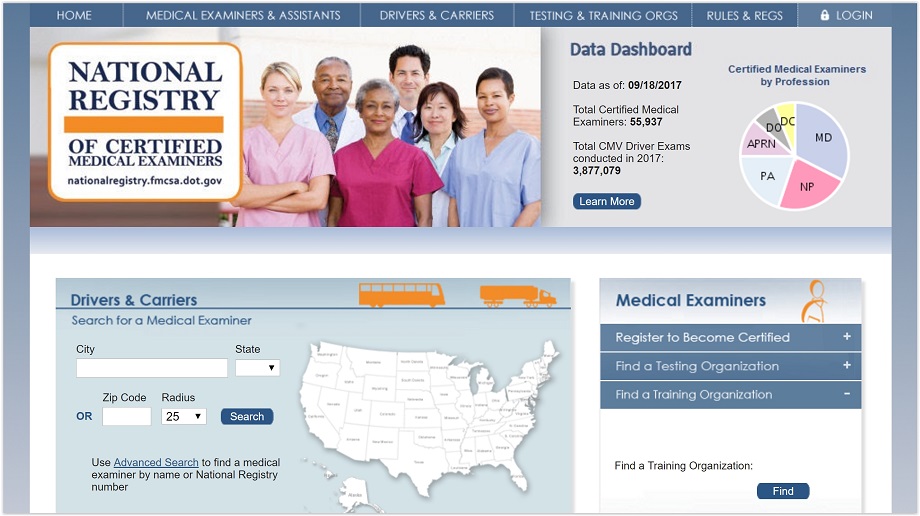
There are more than 55,000 certified medical examiners, make sure you use the services of one of them
Once you have provided all the necessary paperwork, you must pass your exams. All applicants for CDLs must pass a vision exam as well as a knowledge exam. Once you pass these, you will receive your commercial learner's permit (CLP). The Code of Federal Regulations states that you must have your CLP for a minimum of 14 days before you can take your road skills test. (Some jurisdictions may require a longer holding period.) Depending on the state that issues it, a CLP may be either valid for one year and nonrenewable, or valid for less than one year and renewable. Note that your potential employer may list additional requirements on the job application as they try to find CDL drivers with top qualifications.
Forms You'll Need: Medical Examination Report and Medical Examiner's Certificate
Medical Examination Report (MER) Form, MCSA-5875
The Federal Motor Carrier Safety Administration requires that all interstate commercial motor vehicle drivers maintain a current Medical Examiner's Certificate (MEC), Form MCSA-5876 to drive. As part of the physical, drivers are required to fill out the medical history portion of the Medical Examination Report (MER) Form, MCSA-5875.
Download it here.
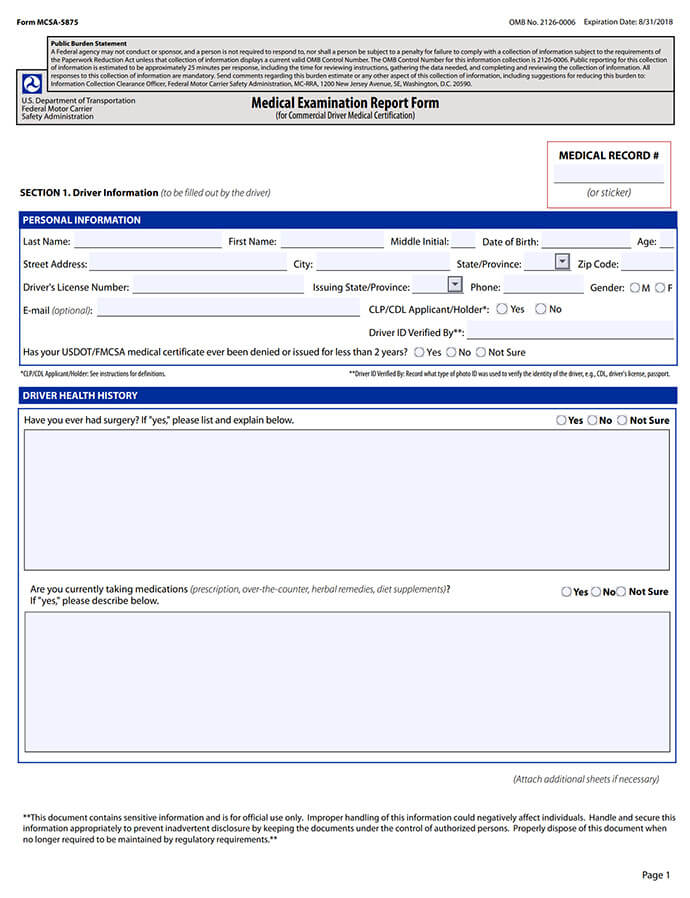
Medical Examiner's Certificate (MEC), Form MCSA-5876
If the Medical Examiner determines that the driver examined is physically qualified to drive a commercial motor vehicle in accordance with the physical qualification standards, the Medical Examiner will complete and provide the driver with a Medical Examiner's Certificate (MEC), Form MCSA-5876. The Medical Examiner will keep a copy of the Medical Examiner's Certificate (MEC), Form MCSA-5876 on file for at least 3 years.
Download it here.
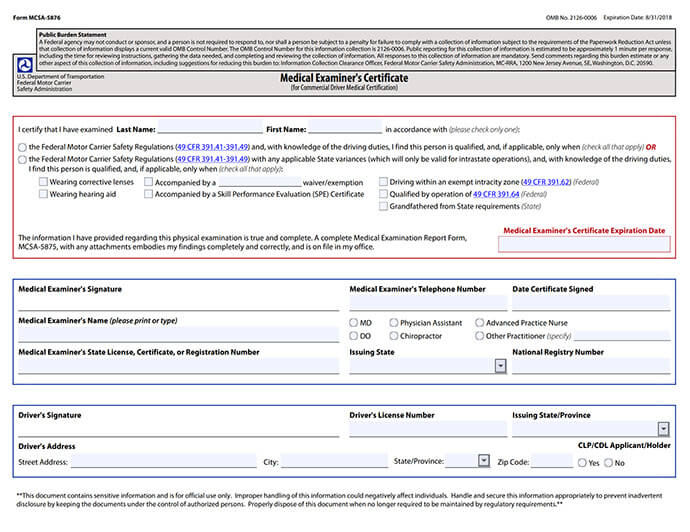
So once you know how to get a CDL license in 2021, how do you determine which license class is right for you? States have tried to make it as simple as possible.
How to Get a Class A License
- everything to get a normal CDL
- pass general CDL knowledge test and Combination Vehicles knowledge test
- bring a class A vehicle to your road skills test
- apply for recommended class A endorsements (such as double-triple)
You need to get a Class A License if you are driving a combination of vehicles with a weight of over 26,000 pounds, and the vehicle that is being towed is over 10,000 pounds. For many states, this would include commercial vehicles that have trailers or semi-trailers with two or more axles.
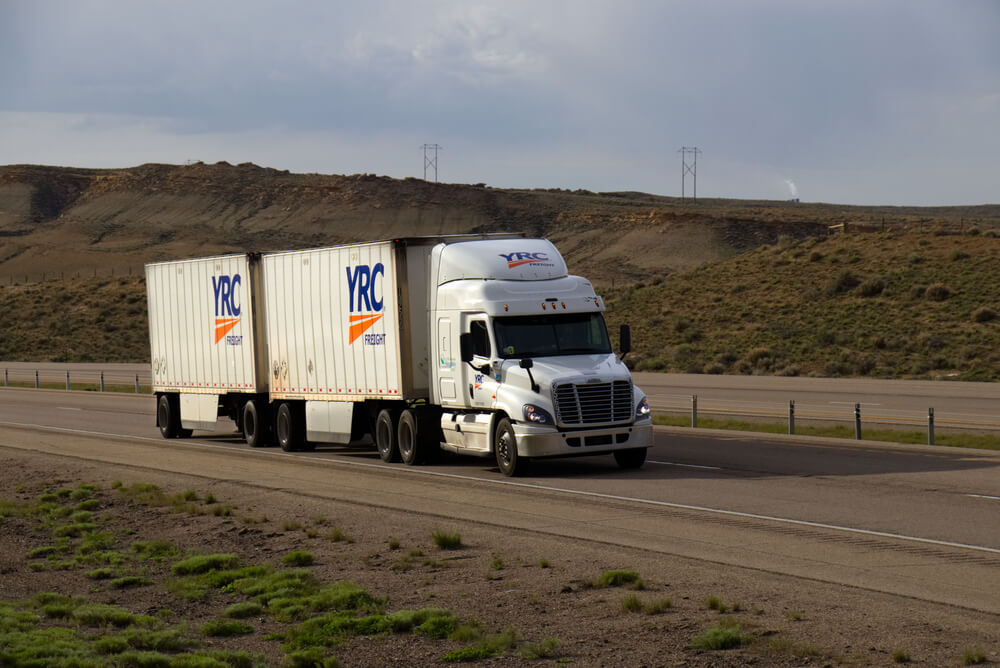
Class A License is the most comprehensive commercial driver's license you can get. It allows you to operate a truck with double and triple trailers used by top trucking companies, as well as other commercial motor vehicles.
To get a Class A license, you need to do everything previously discussed and also pass the Combination written test. First, you need to bring a class A vehicle to your driving skills test. Depending on your particular vehicle and the type of employment you will be seeking, you may need to take extra endorsement exams, such as the Double Triple endorsement exam, which will allow you to drive with double or triple trailers. If your vehicle has air brakes, you'll also need to pass the air brakes test. Once you've filled out all the relevant paperwork, filed all necessary documentation, passed your written and driving tests, you'll have your new class A commercial driver's license!
How to Get a Class B License
- everything to get a normal CDL
- pass general CDL knowledge test
- bring a class B vehicle to your road skills test
- apply for any necessary class B endorsements (air brakes, tanks, etc.)
A Class B license is necessary if you are going to drive a single vehicle that is over 26,000 pounds, and the GVWR of any vehicle being towed is under 10,000 pounds. Because the majority of the weight is in a single vehicle with a class B license, you do not need either the double-triple endorsement or combination endorsement. However, if your vehicle has air brakes or you will be pulling a trailer, you will need to get endorsements for those.
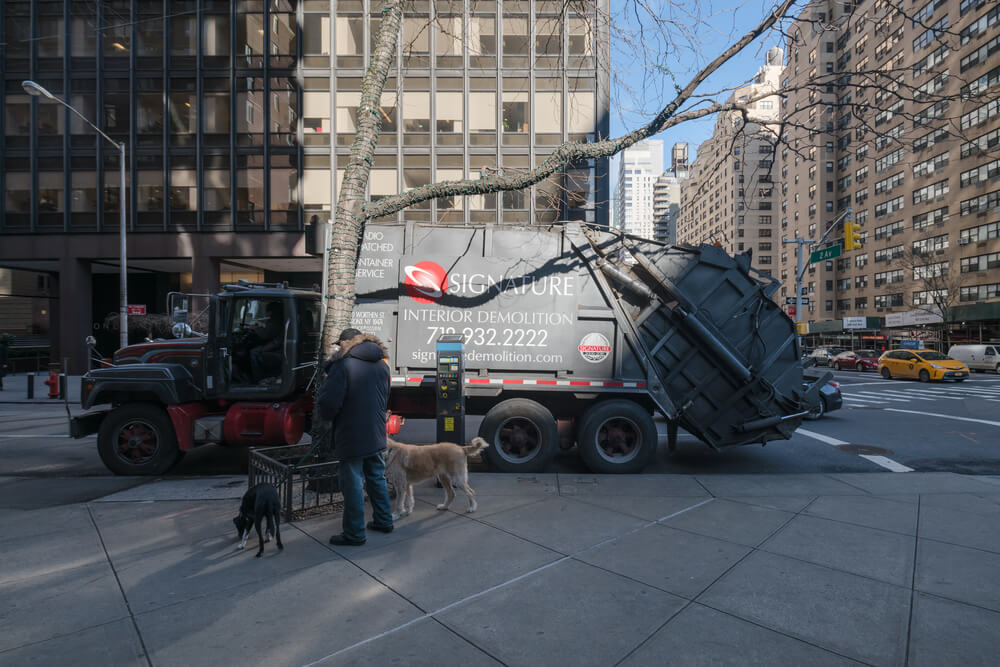
To drive a refuse truck you'll also need an air brakes endorsement in most states
The key to getting on the road with your new class B license is just ticking off the boxes: complete the paperwork, file your medical documents, pass all your exams with flying colors, pay your fees, and that's it.
How to Get a Class C License
- follow the steps to get a CDL
- pass general CDL knowledge test
- bring a class C vehicle to your road skills test
- apply for the necessary endorsement (passenger, school bus, Hazmat, etc.)
If you're going to drive a vehicle for transporting more than 16 passengers or hazardous materials, then you need a class C license. The process of how to get a class C license is very similar to that for the class A or class B licenses though it depends on which type of vehicle you will be driving. The one way in which the class C license is unique is that you must apply for some endorsements with it. If you are just transporting passengers, you will need the passenger transport endorsement. For driving a school bus, you'll need the school bus driver endorsement and the Passenger endorsement.

A school bus endorsement requires you to be able to load kids, operate the lights, stop signs, and other devices on the bus
For hazardous materials transporting, you'll need the Hazmat endorsement. For hazardous materials, you will also need to undergo additional state and/or TSA background checks. Your state may also have additional safety checks for school bus drivers, which should on the state DMV website. As long as you complete and turn in your paperwork and all medical documents, take and pass all necessary tests, pay all required fees, and go through any security checks, you'll soon have your new CDL class C license.
COVID-19 Emergency Rules
For national commerce to cope more effectively with the emergency caused by the COVID-19 (novel coronavirus) pandemic, the Federal Motor Carrier Safety Administration (FMCSA) has issued a series of Emergency Declarations. These declarations have granted relief from some of the usual requirements for commercial driving, such as the following:
- States are allowed to make CLPs valid for longer than one year.
- The holder of a CLP is not required to wait at least 14 days before taking the CDL road skills test.
- A CLP or CDL will remain valid even after the holder's medical certificate or medical variance has expired.
These and other emergency rules have been repeatedly extended or modified by FMCSA as the COVID-19 emergency has continued. You can learn about the status of the COVID-19 emergency rules here.
Things You Don't Need

Don't pay money for what you don't need
A commercial driving school will provide both classroom and behind-the-wheel training. But what if you feel you need more written instruction than the school's basic course provides? Before spending more of your money on additional classroom instruction, consider whether you could learn more from some online instruction websites. For example, there are plenty of free high-quality CDL practice tests available online here on driving-tests, without requiring you to sign in, or provide personal information or commitment of any kind. Note: you do not need to pay for your state's CDL manual. Some websites offer to sell it to you, which is very unethical when it is free on your state's CDL licensing website and free right here, either to read or to download and print. If you check your state's DMV page, they may also list locations where you can get it in print for free.
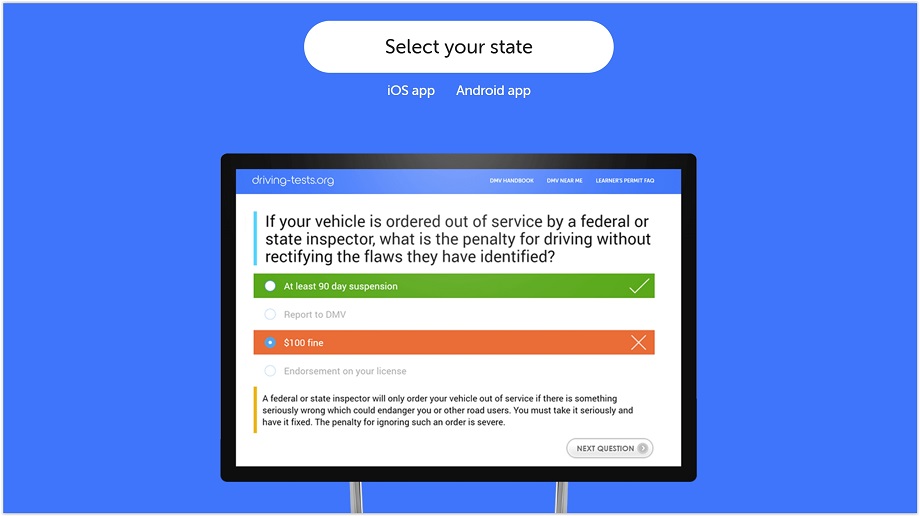
Test prepration made easy- just choose your state and proceed (free CDL tests)
The most important factor in how to get a CDL license is not money – it's your time and determination.
Whether you get a class A, class B, or class C license, we hope to see you on the road soon in 2021!
How To Get A Class B License
Source: https://driving-tests.org/how-to-get-a-cdl-license/
Posted by: coopergreplive.blogspot.com

0 Response to "How To Get A Class B License"
Post a Comment